Life at the Lake
a diary of living at a small lowland lakeWHAT IT'S LIKE
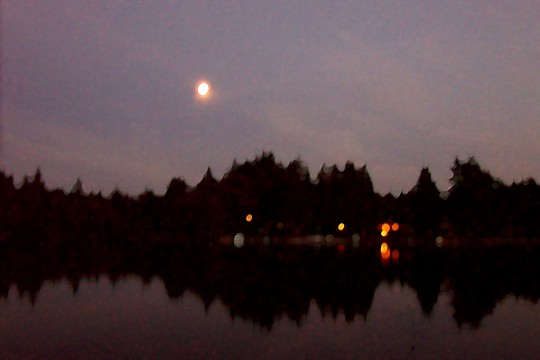
Early moonrise over Lake Ketchum
|
Archive Search |
| Links |
|
and s-integrator |
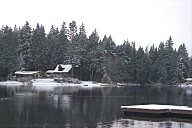
Hail thick as snow descends
Six rapid-fire trout off the dock this evening, including a three-pounder that fought like a blackmouth salmon—while on TV indoors the Lakers lost a miserable game six to San Antonio Spurs and were eliminated from the NBA playoffs.
A cold front then moved in and, with the lake much warmer than the air, a pretty little ground fog settled down and clung to the lake's surface. The clouds darkened and soon it was like night; a pit-pat of heavy rain on the skylight proved to be hail, and soon the ground was soon covered with the stuff to a depth of nearly an inch.
The temperature dropped below fifty, then below forty, and ended up in mid-night into the thirties And this, mid-May, with June fast approaching.
Dawn today was eerily gray and cold, with a thin little light appearing from the East. Normal hard rain, but quickly over, nothing but a shower.
At the feeder, though, a spectrum of birds, including crows, blackbirds (momentarily at peace with each other), rosy finches, kinglets, chickadees, black-crowned sparrows, Stellar jays, a solitary dumb rufous-sided tohee.
Why dumb? Because they don't recognize windows for what they are and, as a breed, regularly attempt to fly a straight course through them, to their detriment. We are always burying them.
- - Comments ()
...
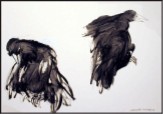
My Two Crows, ink drawing by Kenneth Callahan
BLACKBIRD HECTORING A CROW
Crows are either after the eggs of the red-winged blackbird or else (worse to contemplate) their young.
The blackbirds are nested in the cattails and bulrushes along my shoreline, and I see them come and go like darts during the course of the day, the male as black as his name, but with flame along the leading edges of his wings. (Actually it is two bands of color, one red, the other yellow, which blend in flight to a brilliant orange.) The female is peppery-spotted, a little smaller, non-descript, brownish overall. But she is usually close to the nest, if not upon it. And it is the fierce male that gives fight to the crow, which is probably three to six times the size of the smaller bird.
The male blackbird hectors the crow. He outflies him, keeps after him relentlessly, drives him away from the tall, spiky grasses where the nest is. The crow, much slower, tries to outmaneuver the blackbird but seldom does. It is entirely an aerial battle. Off and on, they continue through the day.
I am on the side of the blackbird, the underdog. This is the American way. I champion him and set aside for the duration my enjoyment of the crow and raven, and their dominion of the sky. Why, the crow will even take on the eagle, much as the blackbird takes on the crow. In this instance, though, I am pretty much on the side of the eagle, even though he is the "overdog."
The eagle—our national bird—is a big sissy. What he eats is preferably dead. He is a bird of prey but mostly a carrion eater. He is after a big, easy meal.
Meanwhile, while the young blackbirds are still in the nest and unable to fend for themselves or fly, the parents fiercely defend their young, and it is a frequent sight on the lake these days, as the crow tries to fend off his attacker, almost as though a human waves off a mosquito.
- - Comments ()
...
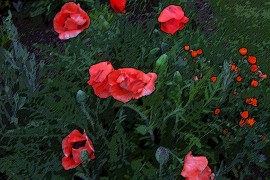
Small poppie cluster from my yard
My father believed in advertising. It was almost a religion to him. He was an executive with a large retail store, a division of Marshall Field and Company. It no longer exists.
Advertising was a kind of truth. If you made a claim, or said something, over and over, it became a fact in the process. A kind of new truth, indisputable.
For example, the red delicious apple was the finest apple in the world. In spite of the fact that it was rather tasteless and meaty. If you served it ice cold, it was better. A kind of subset of the apple religion was to chill it good. There were actually vending machines that dispensed cold delicious apples. The cost? A nickel or a dime, when I was growing up. I'd heard the delicious apple's claim to fame so many times that I had come to believe it, too, as any good American would. Even if they didn't taste very good. (There are apples in the market today whose taste is beyond belief. They come from elsewhere, but grow well here.)
There was a vending machine at the downtown YMCA, where I was made to swim naked and take lessons in the crawl, backstroke, and side stroke. The last named was the only one I did halfway well. After stepping into a medicated bath that was supposed (again wrongly) to protect against athlete's foot, I showered and dressed damply and went out into the lobby and either bought or finagled a huge red apple.
There was a little trick boys performed with the refrigerated vending machines. It was to your advantage if you had a long, skinny arm, which I did. What you did was snake your hand and arm up, way up, from the little hinged door at the bottom until your fingers came to the lowest rotating rack of cold apples that was triggered by a coin inserted in the slot way above. If you stretched your arm far enough, and did it just right, you could trip the lever arm (you would feel this) and the whole rack would shift perceptibly and, quick on the removal of your hand and arm, an apple would tumble down the chute and it would be yours.
Dishonest? You bet. Delicious? Well, that was its name, and if you believed hard enough the apple actually tasted halfway good. Part of that was advertising and another part was as a result of how you obtained it.
- - Comments ()
...
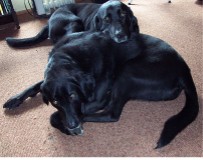
Two Stacked Black Labs, Mine
SCAT!
No, I'm not referring to what you tell the neighbor's cat to do, when it is digging in your flower garden.
That's its real name, when it is produced by wildlife. When done by domestic animals, in households with small children, it takes on a cutesy, euphemistic name. Poo or poop, are common. But its real name is shit. Crap is the frequent euphemism. (But crap is non-specific and may refer to a whole family of undesirable items, including honorable garbage. Besides I like it.)
Our next door neighbors, with kids 8 and 12, call it poop. In their yard they have what is called Poop Patrol, where the kids are assigned to go around their grounds and pick it up in plastic bags—the supermart's great contribution to helping keep our neighborhoods clean of dog crap. The poop that doesn't get patrolled is what their two small dogs leave on their parking strip and mine, and in my yard sometimes.
Luckily their dogs are small; mine are not. (On the lake we need a regulation limiting dogs to five per person—not per household. This is a joke, albeit a sick joke.) But I am a dog lover, and known as one. How can I not be with two black Labs, brother and sister, who weigh 120 and 85 pounds, respectively?
And how do I handle dog shit? With a short handled shovel. No plastic bags for me. I accompany my dogs on their journeys, small and large, and make sure the shit gets deposited to a huge vacant lot hundreds of feet from the lake. The lot is overgrown with blackberries and willow, and has not been visited by its absentee owner in the seven years I've lived at the lake. It is impassable, inaccessible. But my disposal practice might well be questioned by the fastidious. I can only respond, "I do the best with what I have to live with."
Now, other people's dogs and their shit found in my yard makes me furious. I accuse them of Pigism, and worse. I hold that they are socially irresponsible and teach their kids to be the same way. "Shit on your neighbor," seems to be their motto. Well, not personally, but it's okay if their dogs do it.
"Not in my yard," is their motto. "In your yard, okay." This is a corollary of "My yard is my yard. Your yard is my yard, too. And on the other side, his yard is my yard, additonally." (It sounds kinder when you say it in Spanish: "Tu casa est muy casa," etc.)
With dogs as large as mine, it is pretty easy for even the inexperienced to be able to identify your own poop. Or the poop issued forth from the small dogs next door, which upon keen discernment seem to be fed terrible food—mostly candy, I'd guess.
At a lake, animal waste can contribute to fecal coliform bacteria that makes the water toxic. Fortunately our lake has tested minimally in that department, in spite of regular visitations by large extended families of Canada geese. This surprises me and I think we should test every few months, especially in the summertime, for coliform bacteria in the lake that may be the product of failed septic systems, leeching animal waste, and what is not rendered inert by long percolation through the ground from the infamous dairy farm, a full mile away.
And there it is, our topic for today, a subject too tender for me to give it its right and righteous name.
- - Comments ()
...

Petersburg Winter (album cover)
I think I am a Russian at heart. I not only vibrate to their music (well, much of the time), but to their literature, as well. Dostoyevsky in my youth captured me, and I imagined myself transported over the Steppes in a horse-drawn sleigh to a distant inn, buried in fur robes for the journey, coughing slightly, running a low fever.
I'd arrive in a lather, have some borsch for my supper, washed down with vodka, then retire to my upstairs bed, perhaps joined a moment later by an unspeaking Grushenka, as played on the screen by toothy Maria Schell. Ah, sixteen-year-old bliss!
At the start of this music appreciation course, is Tchaikovsky. His "Romeo and Juliet Overture" entranced me. I bought a 78 rpm record, a player, and listened to it over and over. I could whistle it.
I still like him sometimes. His symphonies, though, are a bit deceptive. The great range in their volume reminds me of what Cornelia Midel told me, angrily, at a New Year's Eve party, many years ago. (She is a well-known cellist and the widow of Rainer Midel, conductor of the Seattle Symphony Orchestra.)
When informed that I liked to listen to classical music in the background while I wrote, read, or did other work, she became incensed and told me I must, must, must sit still in a chair (preferably a stiff-backed one, I gathered) and do nothing but listen. Of course she was right, in her old-fashioned sense of what's right in the world, but I am in reality a busy American (not a Russian, after all), who has more important things to do.
She would say, my putting words into her mouth, "There is nothing more important to do." And she would be right, technically speaking. Today, this morning, while I gobbled my Rice Chex, I listened to Tchaikovsky's "Fifth Symphony." Pretty good stuff. But Tchaikovsky wants me to—Cornelia-like—sit and listen and do nothing else. So I submitted, as best I could.
Trouble with those Russians, including Shostakovich, is that they want you to sit and listen, and they use tricks—TRICKS!—to get you to do it. That not only isn't fair, it isn't AMERICAN.
First off, Tchaikovsky starts out so slow that you can't really hear him. I mean, if his music was visual, he'd be invisible. Not a peep. It is as though the orchestra were asleep. Or the audience. Then they, and I, some slowly awake. Do I hear that old familiar theme, played ghostly, somewhere far off, or do I imagine that I do? That's what Tchaikovsky wants you to do, apparently.
So maybe I get up out of my chair and turn the volume on the CD player's amplifier up a notch or two.
Just what he wanted! Another trick played on an unsuspecting American by a treacherous Russian. As the audience and orchestra wake up, by degrees, and those slow degrees, the music microscopically builds in volume. Soon there is no doubt that the music is playing. It is playing louder and louder. There is no question of remaining half-awake, or rather half-asleep. The music is drumming in my ears. It is so loud that it must bother my innocent wife, who only wants to sit in her chair and read. She complains not a word.
It is my fault, not Tchaikovsky's. But I am wise to his tricks; if I rise and turn the volume down, in a minute or two I won't be able to hear his damn music. I've been this route before.
So I sit and endure it, longing for the days (not really) of horse-drawn sleighs and distant inns and Maria Schell warming the bed for sixteen-year-old Me.
- - Comments ()
...
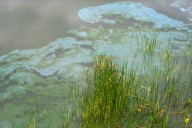
Algae That Looks Like Spilled Paint
Algae.
It is the accompaniment of water weeds and is essential to the health of the lake, yet in abundance it produces a big problem. Algae is mostly chlorophyll and is composed of two types of microorganisms, phytoplankton and zooplankton. The former is vegetable matter, while the latter is animal, however small, which feeds on the tiny vegetable stuff, and also provides food for fish. Daphnia, rotifers, crustaceans are chief among these critters. All are beneficial to the health of a lake.
But there is a kind of algae that is so harmful to humans that it is no longer called vegetative. It is now consider a bacterium. It is the infamous blue/green algae (see above). It looks like someone spilled a can of light blue paint at the water's edge. Also, like the vegetative algae, it will migrate; it will gather and, moved by currents or wind, it will travel along or across the lake and transfer its potential harm from one place to another.
In Brazil, on the Amazon, it has grown prolifically and polluted whole bodies of drinking water, causing deaths. In the United States, though, it may after prolonged exposure cause lung and liver problems, but this is extremely rare. In Washington State it has proved toxic in one instance to cats and small dogs, and the people of Spokane County brought suit against the State Department of Ecology and won damages.
In Seattle's Green Lake it has taken over the lake's surface and caused public warnings to be issued. It is bad stuff and should be stayed away from. Swimming in such water is out of the question. Each year on my lake we encounter it, and not all of it is toxic; we have to have it tested by a special lab, which costs $250 each time, and necessitates a living sample being transported under refrigeration to the lab, 75 miles away.
If the sample is benign, well and good. We are out some money. The awful-looking stuff won't hurt you. But if it is toxic, we issue a warning to the lake residents to stay away, no swimming, and to keep pets (especially small ones) from drinking the water until the stuff is gone. This may take quite a while. (Seattle's Green Lake remained full of the algae for a year.)
Rather than pay for a lot of inconvenient, expensive testing, however, we generally tell people to avoid the stuff until it is gone. Usually it disappears in a matter of days. And there are always some people who know better and continue to swim in nearby areas.
And, what about the county health department? They say they are too busy testing restaurants and wells to bother with our lake. But they say they will issue us some warning signs to post and, once, and once only, they paid for testing a sample. It wasn't toxic and they say they will not pay for a similar test for us in the future.
It figures.
- - Comments ()
...
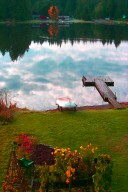
The shoreline is where the weeds accumulate
Because we have a great excess of phosphorous and nitrogen in our lake, the result of decades of fecal pollution from a dairy farmer (who was just trying to make a living), we have special problems. The lake has super-abundant weed and algae. Now, a certain amount of weed is only natural to a lake, and its fish and biota are dependent on it. But too much of a good thing, we are told, is not a good thing.
Our special weed problems consist of elodea and duckweed. The elodea is native, not of the Brazilian sort, and duckweed has its upside, namely lots of pretty widgeons in the fall. But too many ducks constitute a problem, too. Their scat adds to the phosphorous in the lake, which already is excessive by 100 times what it ought to be in a healthy lake.
A normal lake might have, say, 20 to 100 micrograms of phosphorous per liter near its bottom. We have 2000! And up higher in the water column, near the surface, there is not so much—maybe 12 to 24. We have up to 500!
Ironically, seemingly proudly, each year I grandly announce at the meeting of the county lake monitors, "Once again Lake Ketchum beats all the rest of you guys in the production of phosphorous. Eat your hearts out, gang!" And they hoot derisively.
It is amazing, then, that the lake sparkles and the visibility extends down (at present) 2.5 meters and we have lots of quickly growing trout.
The pondweed varieties we have are not unusual, only the amounts, which at present are not large. We have broadleafed, thinleafed, and curly pondweed along the edges—a pretty little shallow-rooted plant. Not so pretty, and a bit intimidating in how strongly rooted it is, is cinquefoil. Each year I pull it out by the yard. There is nothing pernicious about it and I, perhaps unfairly, just don't like its looks.
Weeds I know are important to spinyray production, even though I catch these fish only incidentally, which means in fishers' talk that I do not "target" them. Yet I am only too glad to come in brief contact with a few of each species when I am fishing for trout or (no longer plentiful or even perhaps existent) black crappie. These species are yellow perch, bluegills, pumpkinseeds, green sunfish, brown bullhead, and largemouth bass.
Because we treat our lake along the edges with Sonar, a powerful defoliant, and one of the few permitted by the State Department of Ecology, the weed population becomes greatly diminished by early summer. That is another, nicer way of saying, "We poison our weeds to death." If we don't we will become literally buried in them. Or atleast the lake will.
I dislike our having to do it, but the alternative is even worse. The good news is, having used The Beast for about six consecutive years now, a residual effect is slowly building up and we may not have to do it, or do it often, this year and in the years to come.
Then the yellow pond lily will come back, and some other beneficial weeds, and a little hand-pulling by lakeshore residents may take care of what is individually deemed a problem but is not from an ecological standpoint.
- - Comments ()
...